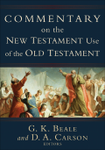In this series of posts, we’ve been exploring why Matthew sees the slaughter of the innocents in Bethlehem as “fulfilling” Jeremiah 31:15, which speaks of Rachel weeping for her lost children at Ramah. In part one of this series, we saw that the connection between Bethlehem and Ramah has to do with Rachel’s death in childbirth on the way to Bethlehem. It appears from 1 Samuel that she died and was buried in the vicinity of Ramah. In part two of this series, we looked at the geographical and historical context of Jeremiah 31:15. There we discovered that in Jeremiah’s day, Rachel was weeping because it was from Ramah that the conquering Babylonians were deporting the captive Jews from Jerusalem. In this post, we’ll conclude by putting all the pieces together so we can understand the point Matthew was trying to make.
When I taught this to my Sunday School class, I explained that Matthew is not merely quoting clear predictive prophecies about the Messiah. Rather, he is associating the events in Jesus’ life with a wide range of events in the history of Israel. I said it’s a bit like that word-association thing psychologists do:
Psychologist: “What do you think of when I say ‘Bethlehem’?”
Matthew: “Rachel’s death.”
P: “And what does that make you think of?”
M: “Her tomb at Ramah.”
P: “And ‘Ramah’?”
M: “Rachel weeping for her lost children!”
If we understand this dynamic, then we can appreciate the parallels Matthew wants his readers to draw.
In Genesis, Rachel dies giving birth while on the road to Bethlehem. In the midst of her suffering, the midwife tries to comfort her with the news that she is having another son. In this way, her child is both her cause of weeping and her hope for the future.
In Jeremiah’s day, Rachel weeps over her children once more, this time because they are being led into captivity and exile near the very spot where she is buried. She is then comforted with the promise that her children will return. Once again, her offspring are both her cause of weeping and her hope for the future.
In Matthew’s day, Rachel weeps yet again: this time over the slaughter of the children at Bethlehem. No words of comfort are given her in Matthew, but the very next verse speaks of Herod’s death and the return of Joseph, Mary, and Jesus to the land of Israel. Just as in Jeremiah’s day, the situation seems bleak, but the hope of salvation lives on.
There are, of course, additional historical parallels in this passage. When the wicked king Herod orders the slaughter of innocent children to protect his rule, we naturally think of the Egyptian pharaoh who ordered the slaughter of Hebrew children. One child, Moses, escaped the slaughter and went on to deliver his people from captivity and exile. In the same way, Jesus escapes the slaughter of the innocents—ironically, by going into exile in Egypt. Like the Israelites, he is led into Egypt by a man named Joseph, a man whom God speaks to in dreams. Like the Jews for whom Rachel wept in Jeremiah’s day, this child knows the experience of living in exile, and like the Israelites of Moses’ day, he goes through his own exodus from Egypt. Just as Rachel was comforted with the promise that her children would be restored, and just as Moses’ birth was a sign that the Israelites’ deliverance was near, so Matthew’s readers are meant to understand that the long-awaited Messiah has been born and the hope of salvation is close at hand.
Obviously, there’s a lot more going on in Matthew’s infancy narrative than most modern readers realize. If you want help in bringing out these kinds of connections, here are some resources you’ll find helpful:
You may find this surprising, but the main resource I used in preparing my Sunday School lesson was our Bible Lands PhotoGuide. It’s tempting to think of the PhotoGuide as primarily a collection of pictures, but it’s actually one of the best places for clear, concise information about biblical sites. The photos are really just the icing on the cake. The PhotoGuide article on Ramah gave me all the relevant passages needed to explain the connection between Ramah and Bethlehem, so that constituted the bulk of my research.

Other resources which help to explain the links between the Old and New Testaments are the various Bible Background Commentaries available from Zondervan and IVP. These are not as narrowly focused on OT and NT parallels as Beale and Carson, but they’ll generally draw your attention to those parallels, along with providing information on the historical background of a passage.
While explaining why Rachel was weeping at Ramah required having my Sunday School class look at a number of different passages together with several maps, they were able to follow my explanation without getting overwhelmed by the details. On the contrary, they were excited to see how all these passages fit together. I hope you’ve found this series helpful—and maybe even a little exciting—as well.

